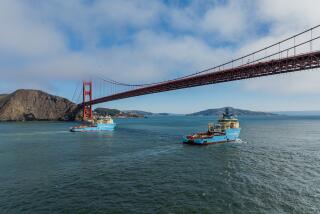Everyone Gains From Clean Ocean
- Share via
Since time immemorial we mariners have always dumped our trash over the side--”deep-sixed it,” as we say. Most of it was quickly converted by the sea into either edible or harmless compounds.
But in the past 30 years, seagoing garbage has included indestructible plastic in enormous quantities. Brad Matsen, the Pacific editor of the “National Fisherman,” zeroes in on the problem when he says that a six-pack ring can last for 450 years. He points out that plastic garbage simply accumulates, and the evidence of our past neglect is only now presenting itself in graphic form.
He says that thousands of marine mammals and millions of birds and fish are killed each year by plastic, either by ingestion of the non-nutritious substance or by fatal entanglement in the debris.
“The image of an elegant bird like a Western grebe strangled by a piece of plastic whose only justification for existance was to get a can of soda from supermarket shelf to the galley table is both pathetic and disgraceful. So is the picture of sea pups mortally trapped in a section of abandoned fish web,” Matsen says.
There is no denying who is responsible for the monofilament gill net, polypropylene line and synthetic trawl web that make their way into the sea. He says the most traceable sources of plastic debris are the fishing fleets. Yet, fishermen clearly have the most to gain by adopting active roles of stewardship for discouraging the plastic plague.
Matsen urges fishermen to take the time to separate plastic debris from degradable garbage thrown into the sea and to take the garbage back to port for less harmful disposal.
“Pack it in, pack it out. Let people know you act responsibly. Encourage enlightened public policy and responsibility in others,” he says.
Recreational boaters should follow Matsen’s advice. There are times during summer weekends when you hardly need a compass to find your way from Newport Beach to Catalina Island. You simply follow the trail of Styrofoam cups and other floating debris jettisoned unthinkingly by yachtsmen and their guests.
We all gain from a clean ocean.
Sailing Notes
The 15th annual Dana Point Series, sponsored by the Dana Point Yacht Club, will begin March 8 with a new non-spinnaker class, a seven-race event. Non-spinnaker classes were added to encourage novice racers. There are no yacht club or fleet membership requirements for this class. Interested sailors may call the yacht club at 496-2900. Race dates are Mar. 8, April 11, June 27, Aug. 2, Sept. 19 and Oct. 18. The spinnaker class races require ratings.
The largest collection of international vessels and big yachts ever assembled on the West Coast can be seen in Newport Beach this year when the in-the-water boat show season begins at Lido Marina Village. More than 400 new and used boats, most larger than 30 feet, will be exhibited for the three shows, beginning March 26 and ending April 12.
Dredge Master Associates will be conducting dredging operations until May 1 in Dana Point Harbor. In Newport Bay, there are dredging operations by Dutra Dredging Co. This operation includes excavation of a sedimentation control basin and side channels within Upper Newport Bay and excavation of an access channel from the basin to a point in Newport Bay below the Pacific Coast Highway bridge. This is a 24-hour operation. Mariners are advised to use caution in this area.
More to Read
Sign up for Essential California
The most important California stories and recommendations in your inbox every morning.
You may occasionally receive promotional content from the Los Angeles Times.










